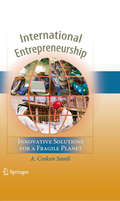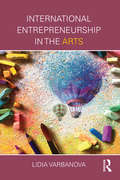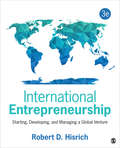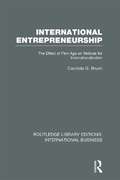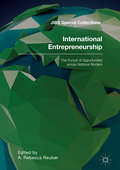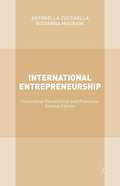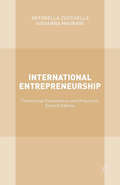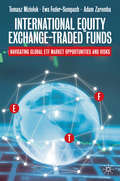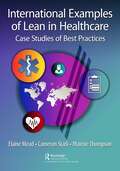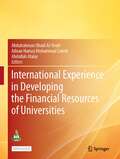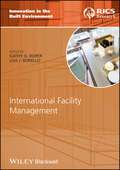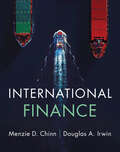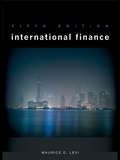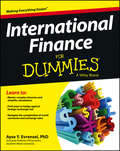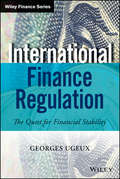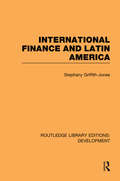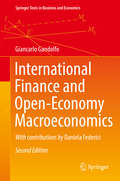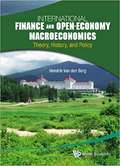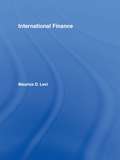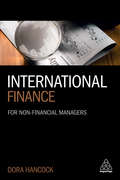- Table View
- List View
International Entrepreneurship
by A. Coskun SamliDespite the accelerating pace of globalization, it is impossible to ignore the marginalization of the developing world, as billions of people continue to slip deeper into poverty. While many theories, policies, and practices have been proposed to help redress the disparities between the "haves" and the "have-nots," only recently have proponents of sustainable economic development and entrepreneurship discovered each other. In this provocative and timely book, A. Coskun Samli fills the gap by making the connections explicit and arguing that entrepreneurship may be the only hope for countries that have fallen into the trap of relying on foreign aid and bowing to the pressures of multinational conglomerates driven by short-term profit-maximizing goals. Samli builds the case that some cultures are more entrepreneurial than others, and demonstrates the importance of creating the right conditions, infrastructure, policies, and educational systems that inspire and support new business creation.
International Entrepreneurship in Emerging Markets: Contexts, Behaviours, and Successful Entry (Routledge Studies in International Business and the World Economy)
by Léo-Paul Dana Vahid Jafari-SadeghiInternational Entrepreneurship in Emerging Markets: Contexts, Behaviours, and Successful Entry aims to provide a comprehensive understanding of international entrepreneurship in emerging markets. This collection of prominent, context-based chapters focuses on entrepreneurial activities in SMEs and analyses a specific dimension of international entrepreneurship in countries belonging to emerging markets. In a constantly evolving international business context, economies can play a crucial role in the promotion and support of firms looking for expanding their market globally. As such, internationalisation, considered as among the most challenging strategies, can provide an opportunity for Small and Medium-Sized Enterprises (SMEs) to seek for performance and growth. In this vein, although international business literature has prominently focused on developed countries, the contribution of emerging markets (EMs) has become as increasingly important contenders on the global scene. Emerging markets are known as growing fast economies, in which they provide an opportunity for SMEs to operate. Therefore, entrepreneurial firms, SMEs in particular, can take advantage of the context unique characteristics of emerging markets to successfully operate and grow not only in domestic but also in international markets. This book is essential reading for researchers, scholars, and practitioners seeking international entrepreneurial activities related to emerging markets..
International Entrepreneurship in Emerging Markets: Contexts, Behaviours, and Successful Entry (Routledge Studies in International Business and the World Economy)
by Léo-Paul Dana Vahid Jafari-SadeghiInternational Entrepreneurship in Emerging Markets: Contexts, Behaviours, and Successful Entry aims to provide a comprehensive understanding of international entrepreneurship in emerging markets. This collection of prominent, context-based chapters focuses on entrepreneurial activities in SMEs and analyses a specific dimension of international entrepreneurship in countries belonging to emerging markets. In a constantly evolving international business context, economies can play a crucial role in the promotion and support of firms looking for expanding their market globally. As such, internationalisation, considered as among the most challenging strategies, can provide an opportunity for Small and Medium-Sized Enterprises (SMEs) to seek for performance and growth. In this vein, although international business literature has prominently focused on developed countries, the contribution of emerging markets (EMs) has become as increasingly important contenders on the global scene. Emerging markets are known as growing fast economies, in which they provide an opportunity for SMEs to operate. Therefore, entrepreneurial firms, SMEs in particular, can take advantage of the context unique characteristics of emerging markets to successfully operate and grow not only in domestic but also in international markets. This book is essential reading for researchers, scholars, and practitioners seeking international entrepreneurial activities related to emerging markets.
International Entrepreneurship in the Arts
by Lidia VarbanovaInternational Entrepreneurship in the Arts focuses on teaching students, artists, and arts managers specific strategies for expanding creative ventures that are already successful domestically to an international audience. Varbanova’s accessible writing outlines a systematic theoretical framework that guides the reader from generating an innovative idea and starting up an international arts enterprise to its sustainable international growth. Applying concepts, models, and tools from international entrepreneurship theory and practice, Varbanova analyzes how these function within the unique setting of the arts and culture sector. The book covers: Domestic inception of an arts enterprise, followed by international expansion Starting up an international arts venture in the early stages of its inception Presenting an arts activity or project in a foreign country or region Financing a startup venture with international resources Implementing diverse models of international partnership Starting up an arts venture that is run by a multinational team Creating an art product with international dimension The book’s 23 case studies and 54 short examples feature disciplines from fine arts and photography to music, theatre, and contemporary dance, and cover ventures in over 20 countries to provide students with practical insight into the issues and challenges facing real arts organizations. Aimed at students interested in the business aspects of arts and cultural ventures, it will also be of use to practitioners looking at ways to internationalize their own enterprises.
International Entrepreneurship: Starting, Developing, and Managing a Global Venture
by Robert D. HisrichCombining comprehensive coverage with a wide variety of real-life cases, International Entrepreneurship: Starting, Developing, and Managing a Global Venture gives entrepreneurs the tools they need to successfully launch international ventures in today’s hypercompetitive world. Bestselling author Dr. Robert D. Hisrich helps students and entrepreneurs develop global business plans, select international opportunities, and determine the best entry strategy. The text also covers practical considerations such as legal concerns, the global monetary systems, global marketing, and global human resource management for entrepreneurs. The fully updated Third Edition provides increased attention to culture and reflects recent changes in our increasingly globalized world. Readers will also be exposed to new cases featuring international activities of entrepreneurs and ventures throughout the world.
International Entrepreneurship: Starting, Developing, and Managing a Global Venture
by Robert D. HisrichCombining comprehensive coverage with a wide variety of real-life cases, International Entrepreneurship: Starting, Developing, and Managing a Global Venture gives entrepreneurs the tools they need to successfully launch international ventures in today’s hypercompetitive world. Bestselling author Dr. Robert D. Hisrich helps students and entrepreneurs develop global business plans, select international opportunities, and determine the best entry strategy. The text also covers practical considerations such as legal concerns, the global monetary systems, global marketing, and global human resource management for entrepreneurs. The fully updated Third Edition provides increased attention to culture and reflects recent changes in our increasingly globalized world. Readers will also be exposed to new cases featuring international activities of entrepreneurs and ventures throughout the world.
International Entrepreneurship: The Effect of Firm Age on Motives for Internationalization (Routledge Library Editions: International Business #Vol. 2)
by Candida BrushThis volume provides important benchmarks for the integration of entrepreneurship and international business. It extends scholarship beyond the firm as single unit of analysis, instead including the role of the founder/entrepreneur. Exploration of this domain discusses possibilities for theory revision or development as well as providing information about an under-researched segment of companies.
International Entrepreneurship: The Pursuit Of Opportunities Across National Borders (JIBS Special Collections)
by A. Rebecca ReuberThis book provides a broad understanding of what it means to internationalise entrepreneurially. The collection of prominent articles provides insights into how entrepreneurs are entering foreign markets in order to fuel growth. Authors highlight the factors enabling internationalisation under the resource constraints of newness or smallness: human capital, capabilities, networks, processes and practices and environmental conditions. Attention is also paid to the institutional arrangements that impact the practice of entrepreneurship internationally. Inclusive of an introductory chapter that presents a comprehensive discussion of past research themes and identifies new areas of research, this book is essential reading for scholars, policy-makers and practitioners who want to understand how individuals and firms pursue opportunities across national borders.
International Entrepreneurship: Theoretical Foundations and Practices
by Antonella Zucchella Giovanna MagnaniInternational Entrepreneurship.
International Entrepreneurship: Theoretical Foundations and Practices; Second Edition (The\mcgill International Entrepreneurship Ser.)
by Antonella Zucchella Giovanna MagnaniOver the past two decades international entrepreneurship has become a key issue in international business studies. This second edition of International Entrepreneurship examines this key emerging issue from its foundations; entrepreneurship, strategic management and international business studies. The book proposes an integrated interpretive framework in which to place international entrepreneurship, examining both theoretical and practical interests. It asserts that firms faced by global competitive pressures need to develop proactive and innovative responses to cope with the uncertainties of international markets and instead capture the opportunities. This book presents a common framework to complement the growing contributions to this topical and lively subject.
International Equity Exchange-Traded Funds: Navigating Global ETF Market Opportunities and Risks
by Adam Zaremba Tomasz Miziołek Ewa Feder-SempachThis book presents the economic foundation of international equity investments providing a practical guide to invest in international equity exchange-traded funds (ETFs). It shows how to gain exposure to foreign stock markets through both theoretical foundations of international diversification and in-depth characteristics of global, regional, country-specific, and international sector/thematic ETFs. Unlike other books in the field which broadly discuss different aspects of the ETF market, this book explores one specific market segment, offering the first in-depth and state-of-the-art analysis of international equity ETFs and including, in particular, ETFs with global, regional, single-country, and international sector/thematic exposures. The number and variety of such financial instruments are constantly growing. Hence, it seems obvious that there is an urgent need for a book that will help investors who are willing to diversify their portfolios outside the domestic market—in both developed and emerging/frontier markets. International Equity Exchange-Traded Funds presents a comprehensive review of investment possibilities offered by international ETFs for stock market investors.
International Evidence on Recovery from Recessions
by Valerie Cerra Sweta C. Saxena Ugo PanizzaA report from the International Monetary Fund.
International Examples of Lean in Healthcare: Case Studies of Best Practices
by Elaine Mead, Cameron Stark, and Maimie ThompsonTypically entrenched and systemic, healthcare problems require the sort of comprehensive solutions that can only be addressed by a change in culture and a shift in thinking. Organizations around the world are using Lean to redesign care and improve processes in a way that achieves and sustains meaningful results for patients, staff, physicians, and health systems. This book demonstrates how honest appraisal, intelligent planning, and vigilant follow-up have led to dramatic improvements in a variety of healthcare settings across the world. It teaches us how innovative organizations can find sustainable solutions to seemingly intractable problems by following a path guided by Lean Thinking. Lean methods may not solve every healthcare problem, but as these cases prove, changing a culture rather than personnel results in more effective sustainable change. This multi-authored book provides expert descriptions of Lean methods and their application in healthcare, written by the people who developed and tested the methods in healthcare settings. Each chapter brings together a description of the technique or approach, with examples of application in practice from the author’s own practice. Authors use an engaging approach to their narrative, with examples from their personal experience or engagement being described to illustrate the practical application of theoretic approaches. In painting a picture of the environment in which these tools and techniques have been applied, readers will understand the transferability to their own workplace environment. This will be an opportunity to tell real stories of the application of Lean in healthcare and give readers the opportunity to learn from people from across the world, on subjects on which they are acknowledged topic experts, based on day-to-day Lean practice.
International Experience in Developing the Financial Resources of Universities
by Abdulrahman Obaid AI-Youbi Adnan Hamza Mohammad Zahed Abdullah AtalarThis open access book aims to present the experiences and visions of several world university leaders, providing strategies and methods used to find various income sources for their institutions. The expansion of a university system requires a corresponding increase in funding. Consequently, university administrators all over the world are in a constant search for additional funds. If higher-level institutions are expected to deliver high-quality education and research, their sustainable funding is crucial to the development of the countries they serve. While governmental sources are a major part of the funding of most universities, economic downturns as in the case of the COVID-19 crisis may reduce governmental contributions in this and cause administrators to look for various alternative sources to help them compete in a global setting. This book offers valuable information and guidance to university leaders and administrators worldwide especially at a time when university budgets are under stress due to the COVID-19 pandemic with its dire financial and economic consequences.
International Facility Management
by Lisa Borello Kathy RoperThis up-to-date compilation of topics on the maturity and changes occurring within facility management worldwide offers insights into the growth and development of FM and its impact on today's business organisations.International Facility Management presents a comprehensive and diverse collection of topics that provides current, cutting edge research in the evolving field of FM. The editors here offer a holistic approach to both the study and the practice of facility management, incorporating the perspective of scholars and practitioners from across the globe.Topics covered deal with the changes occurring in the field today and include key research areas for both academics and practitioners. The focus is on actual practice of FM organizations - rather than on what FM should be - and the authors examine the latest techniques, models and case studies to provide a unique exploration of the new global world of facility management.Chapters here cover the changing spectrum of topics including sustainability and energy conservation, and workplace transitions for greater collaboration. The international scope and emphasis on maturity and professionalism of the field further sets this book apart from its competitors.
International Finance
by Menzie D. Chinn Douglas A. IrwinUnderstanding the globalized world economy is more important than ever before. This book provides a clear, concise, and up-to-date look at the economic foundations of international finance. The authors explain the principal concepts in an engaging and accessible manner open to students from any discipline, incorporating contemporary finance data through full-colour diagrams and graphs. Throughout, economic models are discussed in the context of recent and current international finance issues, to ensure students gain a concrete understanding and see how the field impacts the real world. Written for upper undergraduate courses, the book includes feature boxes that marry theory and economics in practice to show models applied, a featured real-world application for every chapter, and over 140 end-of-chapter questions help students fully engage with and consolidate their learning. Online resources for instructors include a solutions manual, lecture slides and the book figures as JPEGs.
International Finance
by G. ShailajaAn exchange rate risk management, the working of the foreign exchange market and its institutional framework, and guidelines governing the Indian foreign exchange market. This book is designed to meet the curricular requirements of a postgraduate course.
International Finance 5th Edition
by Maurice D. LeviThe fifth edition of Maurice D. Levi's classic textbook has been updated to incorporate the massive changes in the world of international finance of the past few years. In particular, the emergence of new markets is given broad coverage - particularly the rise to financial prominence of China and India and other growth economies in Asia and elsewhere. Key features of the book include: the impact of globalization and the greater connectedness of national economies and the world economy as a whole probably the best introduction to exchange rates available and how they directly impact upon firms as well as governments the continued massive impact of multinational corporations on the global financial scene as well as the opportunities presented by e-commerce. The material is interlaced with a wealth of supplementary material including real world case studies, review questions, examples and objectives. The result is the most authoritative survey of international finance currently available. Thoroughly updated and with a large amount of new information, this text will prove an indispensable guide to the inner workings of international finance to students of economics and business as well as professionals in the finance industry.
International Finance For Dummies
by Ayse EvrenselWant to get the most out of your International Finance course?Nowadays the value of daily foreign exchange trading is more than one hundred times the value of annual international trade in goods and services. As result of the great importance of international financial transactions, the subject of international finance continues to develop as fast as--or faster than--any other field in economics and finance. International Finance For Dummies sheds light on this increasingly important subject for the growing number of students required to take this course. If you're an undergraduate or MBA student enrolled in an international finance course, this hands-on, friendly guide gives you everything you need to succeed. Plus, it includes up-to-date information on the latest changes to International Finance Reporting Standards, its impact on a company's overall finances, and the various currencies and institutions available worldwide.Serves as an excellent supplement to your international finance textsProvides easy-to-understand explanations of complex materialBrings you up-to-speed on the concepts and subject matter you need to know International Finance For Dummies is your ticket to scoring your highest in your international finance course.
International Finance Regulation
by Georges UgeuxAs the global market expands, the need for international regulation becomes urgentSince World War II, financial crises have been the result of macroeconomic instability until the fatidic week end of September 15 2008, when Lehman Brothers filed for bankruptcy. The financial system had become the source of its own instability through a combination of greed, lousy underwriting, fake ratings and regulatory negligence. From that date, governments tried to put together a new regulatory framework that would avoid using taxpayer money for bailout of banks. In an uncoordinated effort, they produced a series of vertical regulations that are disconnected from one another. That will not be sufficient to stop finance from being instable and the need for international and horizontal regulation is urgent. This challenge is the focus of Georges Ugeux's book.International Finance Regulation: The Quest for Financial Stability focuses on the inspirations behind regulation, and examines the risks and consequences of fragmentation on a global scale. Author Georges Ugeux has four decades of experience in the legal and economic aspects of international business operations. He created and run the New York Stock Exchange'sinternational group in charge of developing the NYSE's reach to non-US companies, including relationships with regulators and governments. Ugeux teaches European Banking and Finance of the Columbia University School of Law. Ugeux is uniquely positioned to provide recommendations and suggestions from the perspective of a top global authority. In the book, he explores international regulation with topics such as:* Laws, regulations, and risks of overregulation* Transformation of the U.S. market and creation of the Eurozone* Development of a global framework and stability of the banking system* In-depth examination of Basel III, the Dodd-Frank Act, the European Banking Union, and the Volcker RuleThe book also contains case studies from real-world scenarios like Lehman, CDS, Greece, the London Whale, and Libor to illustrate the concepts presented. Finance consistently operates within an increasingly global paradigm, and an overarching regulation scheme is becoming more and more necessary for sustainable growth. International Finance Regulation: The Quest for Financial Stability presents an argument for collaboration toward a comprehensive global regulation strategy.
International Finance and Latin America (Routledge Library Editions: Development)
by Stephany Griffith-JonesThis reissue, initially published in 1984, examines the evolution of international financial flows to Latin America since 1945, along with their implications for National Development . The book describes how, in each of the first three decades since the war, a new agency emerged (foreign investors in the 1950s, official aid agencies in the 1960s and multinational banks in the 1970s) which was willing to play a dynamic role in generating new financial flows to the region. The lack of such an agent in the 1980s, combined with a reluctance on the part of former investors to maintain their level of assistance culminated in an economic debt crisis in Latin America which this work seeks to address, asking the crucial question: what measures should be taken – both nationally and internationally – to deal with this critical issue , in a way that will both encourage Latin American Development and avoid a major international financial crisis?
International Finance and Open-Economy Macroeconomics
by Giancarlo GandolfoThis rigorous textbook tames technicalities and makes even the most complex models accessible to students. Its unique two-tier structure makes the book attractive for undergraduates, graduates and researchers alike. In fact, the coverage is primarily directed to undergraduate students and is mainly confined to graphic analysis and to some elementary algebra. Further, each chapter has its own mathematical appendix, in which (i) the topics treated in the text are examined at a level suitable for advanced undergraduates, graduates and researchers, and (ii) generalizations and/or topics not treated in the text (including some at the cutting edge of research) are formally examined. The new edition has been thoroughly revised and updated to reflect the latest research on international finance. This book deals with the financial side of international economics and covers all aspects of international finance. There are many books and articles by exponents of alternative points of view. I know of no other book that provides the scope, balance, objectivity and rigor of this book. the late Professor Jerome L. Stein, Brown University This book is a second edition of a volume on international finance first published in 2001. Like Giancarlo's other books in International Economics, this book is organised as a two-books-in-one by distributing the material between text and appendices. The text provides coverage suitable for an undergraduate course while the mathematical appendices provide coverage of the topics at the frontier of the discipline and suitable for advanced undergraduate or graduate students in an international finance and international macroeconomics course. This edition updates the earlier volume and covers all the classic topics as well as the more recent advances in the theory and modelling of international finance. It includes some discussion of the empirical testing of these theories and where appropriate reference to the extensive empirical literature is also provided. This book is a valuable addition to the bookshelf of any serious International Finance Scholar and provides a treasure chest of material for any quality international finance course. Professor Pasquale M Sgro, Deakin University Giancarlo Gandolfo is one of the profession's most gifted textbook authors on mathematical modeling and international economics. His revised International Finance and Open-Economy Macroeconomics is remarkable for its scope and clarity. The book covers the older and intertemporal approaches, and topics that are usually left out of graduate treatments (the chapter on balance-of-payments accounting is a gem). Gandolfo's two-tier approach of first developing topics with graphs and basic algebra and then providing rigorous mathematics for each topic makes the book ideal for advanced undergraduate and graduate classes. Professor Michael D. Goldberg, University of New Hampshire
International Finance and Open-Economy Macroeconomics: Theory, History, and Policy
by Hendrik Van Den BergThis historically-based textbook on international finance and open-economy macroeconomics provides a complete course on the theory and policies that shaped our international financial system. Utilizing the 1944 Bretton Woods Conference as a unifying theme, the book covers all the standard topics of international finance, such as foreign exchange markets, balance of payments accounting, macroeconomic policy in an open economy, exchange rate crises, multinational enterprises, international banking, and the evolution of our international financial system. The detailed international financial theory is presented in a lively manner that reflects the close relationship between actual world events and the development of economic thought.The book also analyzes the causes of the 2008 international financial crisis and recession, encourages critical thinking about whether the current international financial system promotes human well-being, and concludes with a discussion on whether it is time to summon the world's financial leaders to another Bretton Woods Conference. In additional to providing students with a solid understanding of international finance and open-economy macroeconomics, the book is written in a reader-friendly style that makes it a good reference for anyone interested in the many fascinating issues related to our still-evolving global financial system and, more generally, our global economy.
International Finance: Contemporary Issues
by Maurice D. Levi Dilip DasIn this updated fourth edition, author Maurice Levi successfully integrates both the micro and macro aspects of international finance. He sucessfully explores managerial issues and focuses on problems arising from financial trading relations between nations, whilst covering key topics such as:* organization of foreign exchange markets* determination of exchange rates * the fundamental principles of international finance* foreign exchange risk and exposure* fixed and flexible exchange rates.This impressive new edition builds and improves upon the popular style and structure of the original. With new data, improved pedagogy, and coverage of all of the main developments in international finance over the last few years, this book will prove essential reading for students of economics and business.
International Finance: For Non-Financial Managers
by Dora HancockInternational Finance offers a clear and accessible introduction to the fundamental principles and practice of international finance in today's world, from the international financial environment and exchange rates, to financing multinational companies and international investment. The theory and techniques are presented with the non-financial manager in mind, and the theoretical material is supplemented by case studies and a discussion of the appropriateness of the various techniques and principles to solve practical problems. This book draws from examples and practice around the world, helping students of international corporate finance, particularly non-specialist finance students, understand the complexities of modern Europe and comparative systems of finance globally. International Finance is essential reading for anyone studying international finance or needing an up-to-date, engaging resource to help them navigate the complicated and ever-changing global financial world. Key theories and terms are explained and defined, avoiding unnecessary jargon and acknowledging that many readers are coming to the subject with little or no prior knowledge of corporate finance at all.
